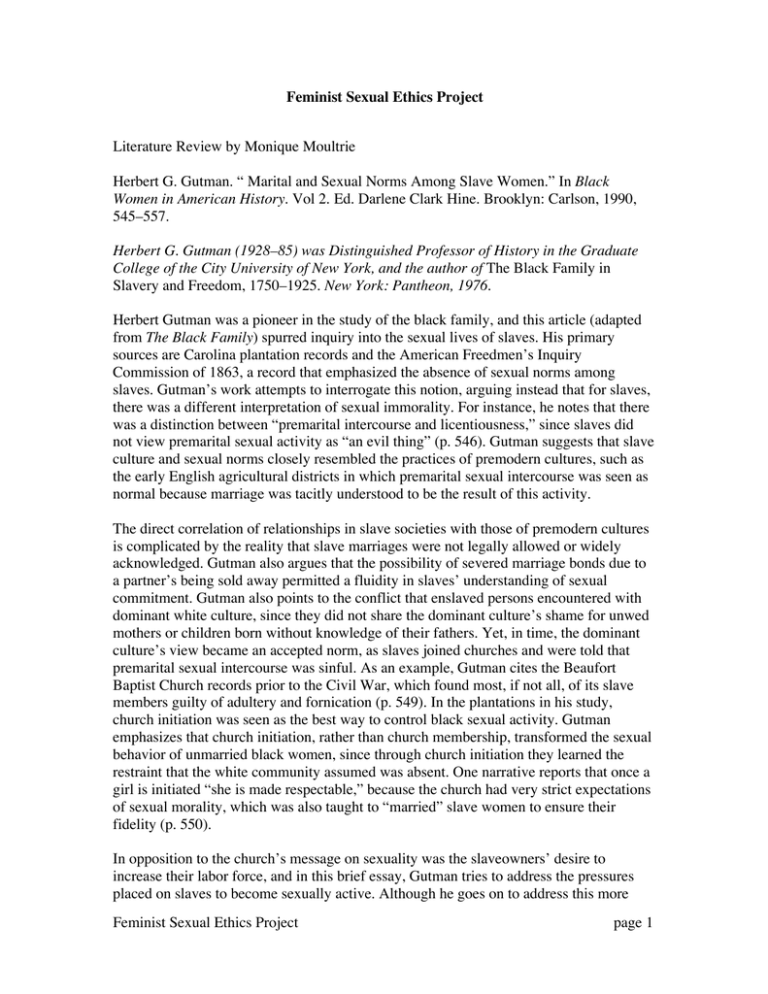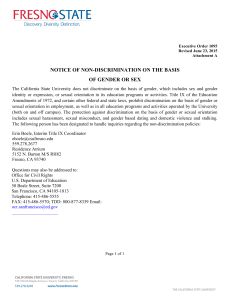Literature Review by Monique Moultrie Black 545–557. Feminist Sexual Ethics Project
advertisement

Feminist Sexual Ethics Project Literature Review by Monique Moultrie Herbert G. Gutman. “ Marital and Sexual Norms Among Slave Women.” In Black Women in American History. Vol 2. Ed. Darlene Clark Hine. Brooklyn: Carlson, 1990, 545–557. Herbert G. Gutman (1928–85) was Distinguished Professor of History in the Graduate College of the City University of New York, and the author of The Black Family in Slavery and Freedom, 1750–1925. New York: Pantheon, 1976. Herbert Gutman was a pioneer in the study of the black family, and this article (adapted from The Black Family) spurred inquiry into the sexual lives of slaves. His primary sources are Carolina plantation records and the American Freedmen’s Inquiry Commission of 1863, a record that emphasized the absence of sexual norms among slaves. Gutman’s work attempts to interrogate this notion, arguing instead that for slaves, there was a different interpretation of sexual immorality. For instance, he notes that there was a distinction between “premarital intercourse and licentiousness,” since slaves did not view premarital sexual activity as “an evil thing” (p. 546). Gutman suggests that slave culture and sexual norms closely resembled the practices of premodern cultures, such as the early English agricultural districts in which premarital sexual intercourse was seen as normal because marriage was tacitly understood to be the result of this activity. The direct correlation of relationships in slave societies with those of premodern cultures is complicated by the reality that slave marriages were not legally allowed or widely acknowledged. Gutman also argues that the possibility of severed marriage bonds due to a partner’s being sold away permitted a fluidity in slaves’ understanding of sexual commitment. Gutman also points to the conflict that enslaved persons encountered with dominant white culture, since they did not share the dominant culture’s shame for unwed mothers or children born without knowledge of their fathers. Yet, in time, the dominant culture’s view became an accepted norm, as slaves joined churches and were told that premarital sexual intercourse was sinful. As an example, Gutman cites the Beaufort Baptist Church records prior to the Civil War, which found most, if not all, of its slave members guilty of adultery and fornication (p. 549). In the plantations in his study, church initiation was seen as the best way to control black sexual activity. Gutman emphasizes that church initiation, rather than church membership, transformed the sexual behavior of unmarried black women, since through church initiation they learned the restraint that the white community assumed was absent. One narrative reports that once a girl is initiated “she is made respectable,” because the church had very strict expectations of sexual morality, which was also taught to “married” slave women to ensure their fidelity (p. 550). In opposition to the church’s message on sexuality was the slaveowners’ desire to increase their labor force, and in this brief essay, Gutman tries to address the pressures placed on slaves to become sexually active. Although he goes on to address this more Feminist Sexual Ethics Project page 1 fully in his book, the article attempts to resolve the conflict by arguing that the institution of the slave family served to combat the moral shame placed on slaves. Despite the article’s limitations, its views were revolutionary in the study of the black family, because Gutman’s examination of slaves’ sexuality demonstrated how they both rejected and imposed white standards. His investigation of marital and sexual norms in slave culture acknowledged the presence of a sexual code that functioned in defiance of white oppressive beliefs, a critical acknowledgement to which current researchers are still indebted. http://www.brandeis.edu/projects/fse/ Feminist Sexual Ethics Project page 2



